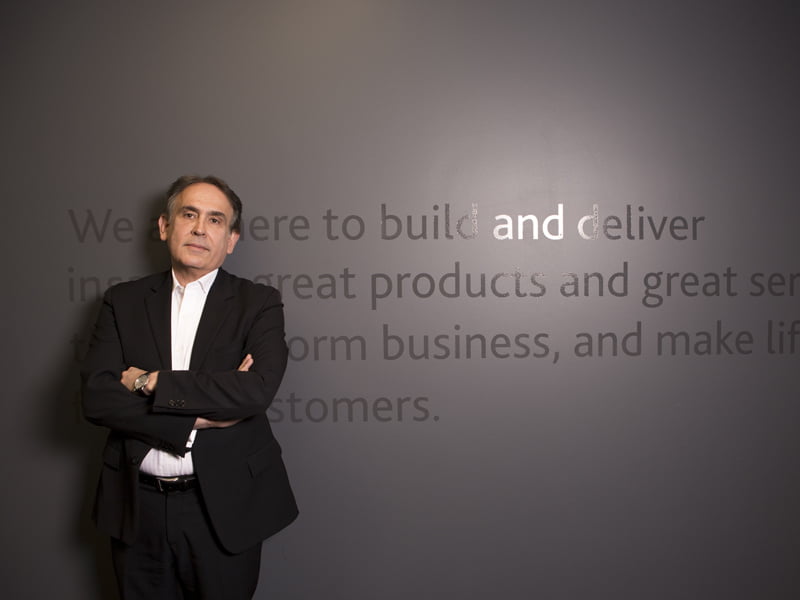Technology One is about to start reinventing itself again, and it hasn’t even concluded the last overhaul. Founder and executive chairman Adrian Di Marco is adamant that companies have to reinvent themselves every 7-10 years to grow and prosper, no matter the success they are currently enjoying.
Founded in 1987, continually profitable since 1992, and listed since 1999, Technology One remains one of the few local software and services companies which have scaled successfully over several decades.
The company began in the green-screen era, shifted its software onto proprietary Prime computers, embraced open systems and client server architectures, and most recently began its journey to the cloud.

It’s yet to make a profit from its cloud business services – last year it lost $2.5 million from cloud and doesn’t expect to make cloud profits before 2017.
Acknowledging that the transition to the cloud had impacted its margins (which dropped from 23 to 21 per cent), in an analyst briefing last week Mr Di Marco predicted that by 2022 the cloud business would be delivering recurring revenues of $143 million. But he’s already moving onto the Next Big Thing; the cloud initiative was labelled C2, now it’s time to get cracking on C3.
“We work on a seven to ten year cycle – anything we are doing as a company only has a life of seven to ten years.”
“We are already starting to talk about C3 and we haven’t finished C2,” he said. C3 isn’t much more than a blank canvas right now, but Mr Di Marco plans to start research in earnest in two years and C3 – whatever it is – will ship five to six years hence.
While there must be a temptation to rest on the laurels of previous success, Mr Di Marco sees that as a recipe for failure, and stressed the need to be “creating these platforms for profitable growth 5-6 years ahead of when you need them.”
He described a very iterative innovation process. “If I look at where C2 started and where it ended up it’s a very different beast. When we started C2 we thought it was going to be A, but it turned out to be Z,” he says.
“As we went down that journey of prototyping and playing with technologies and refining it, it changed dramatically time and time again, but over time it became very clear it was going to be a cloud based solution, software as a service and huge economies of scale and mass production concepts and support any device.”
As C3 takes shape, he said that some ideas will be fast-tracked and integrated into the cloud platform, but where there are ideas that require a fundamental change and which challenge the current product construct, the idea would be mothballed until C3 is ready to fly.
In tandem, the company works out how it can build a bridge so that existing customers can be transitioned to the future as Technology One sees it, otherwise they are likely to go elsewhere.
In 2015 Technology One acquired 58 new customers, 49 of which bought its cloud platform. There are now 70 organisations using the cloud. There are many which still need to cross the bridge.
“We have over 1,000 companies on premise and we’ve got to give them a smooth transition and painless transition to the cloud and Ci Anywhere (which connects any device to the cloud), and when we’ve got them there, we need to give them a smooth and painless transition across to what C3 will be.
“C3 will build on the cloud paradigm – but we don’t think it will have relational database technology. We think that’s a technology of the past. It will be a whole different level of massive scalability – tens of thousands of customers – we think the user experience will be vastly different because the world will have moved into virtual reality. People will have to do lot of rethinking about how people react in overlaid reality.”
Technology One has been able to bring investors along on the innovation ride, because it continues to deliver profit growth. Yes, it plans to spend $700 million on R&D over the next ten years, but that will be expensed in the year it is spent and nothing capitalised. For all the innovation and creativity in evidence, it’s a financially conservative approach.
One area where the company has been relatively slow to move is in gender diversity. It only appointed a woman to the board last week – the well-credentialed Dr Jane Andrews, a co-founder of Implicit Biosciences.
“We’ve been working on this for about five months,” said Mr Di Marco. “We wanted someone really appropriate for company and culture – not go for ASX 200 director that ticks all the corporate governance things.”
“As always, we have thought outside the box and found someone who comes from an innovation and creativity background who understands the whole risk and reward equation of what R&D is about.”
He said that her different background, gender and age all bring fresh perspectives to the company.
Innovation isn’t just limited to products and services, it also needs to be applied to people at the appropriate time.
Mr Di Marco, for example, has signaled his intent to transition out of the company he founded – probably well before C3 arrives.
“It’s just a question of if it’s one, five or seven years? It is hard to transition a business from its founder to a non-founder period – but it never happens if you don’t make that statement and start the journey.
“I’m prepared to let that journey be as fast or as slow as it needs to be.”
Do you know more? Contact James Riley via Email.

